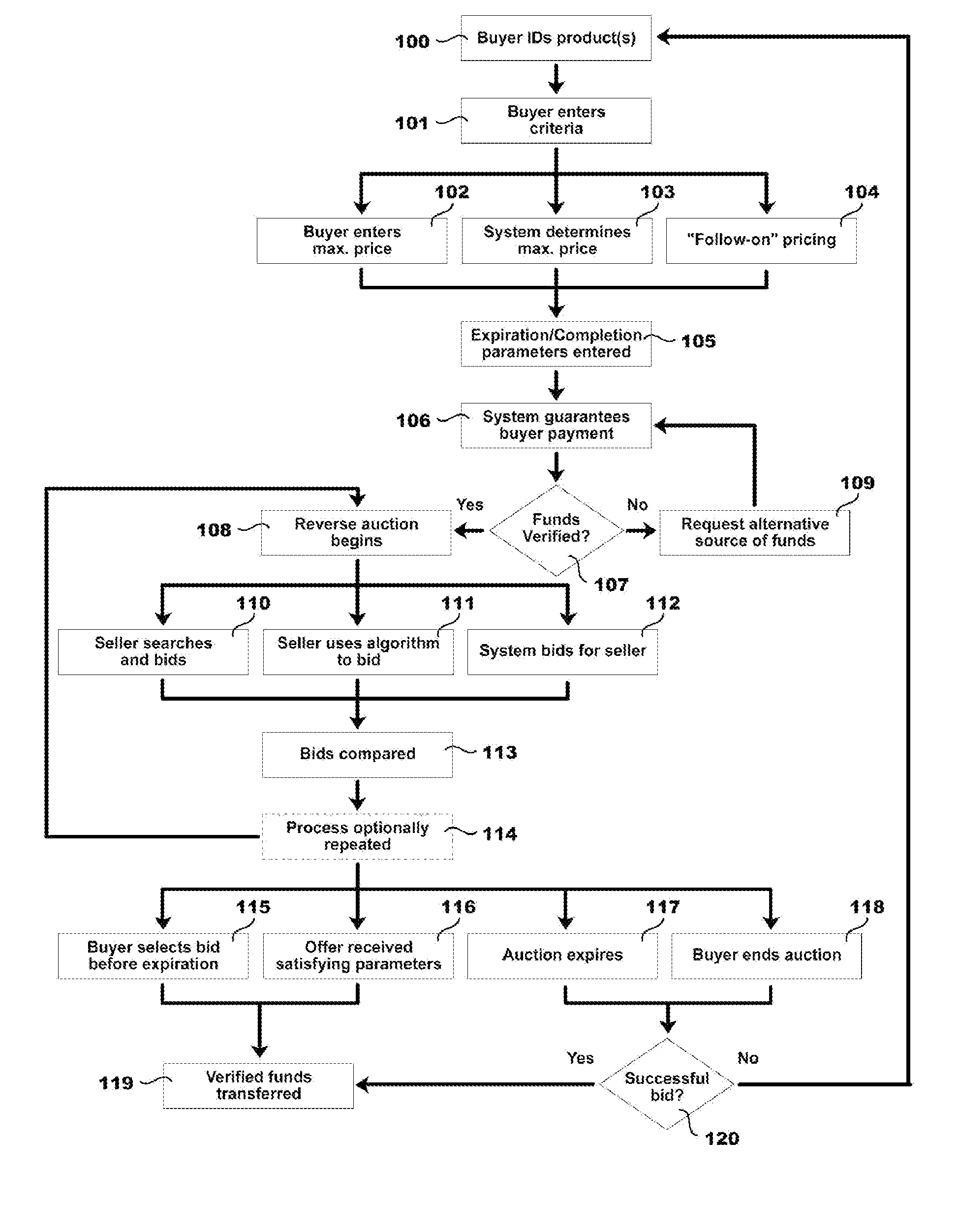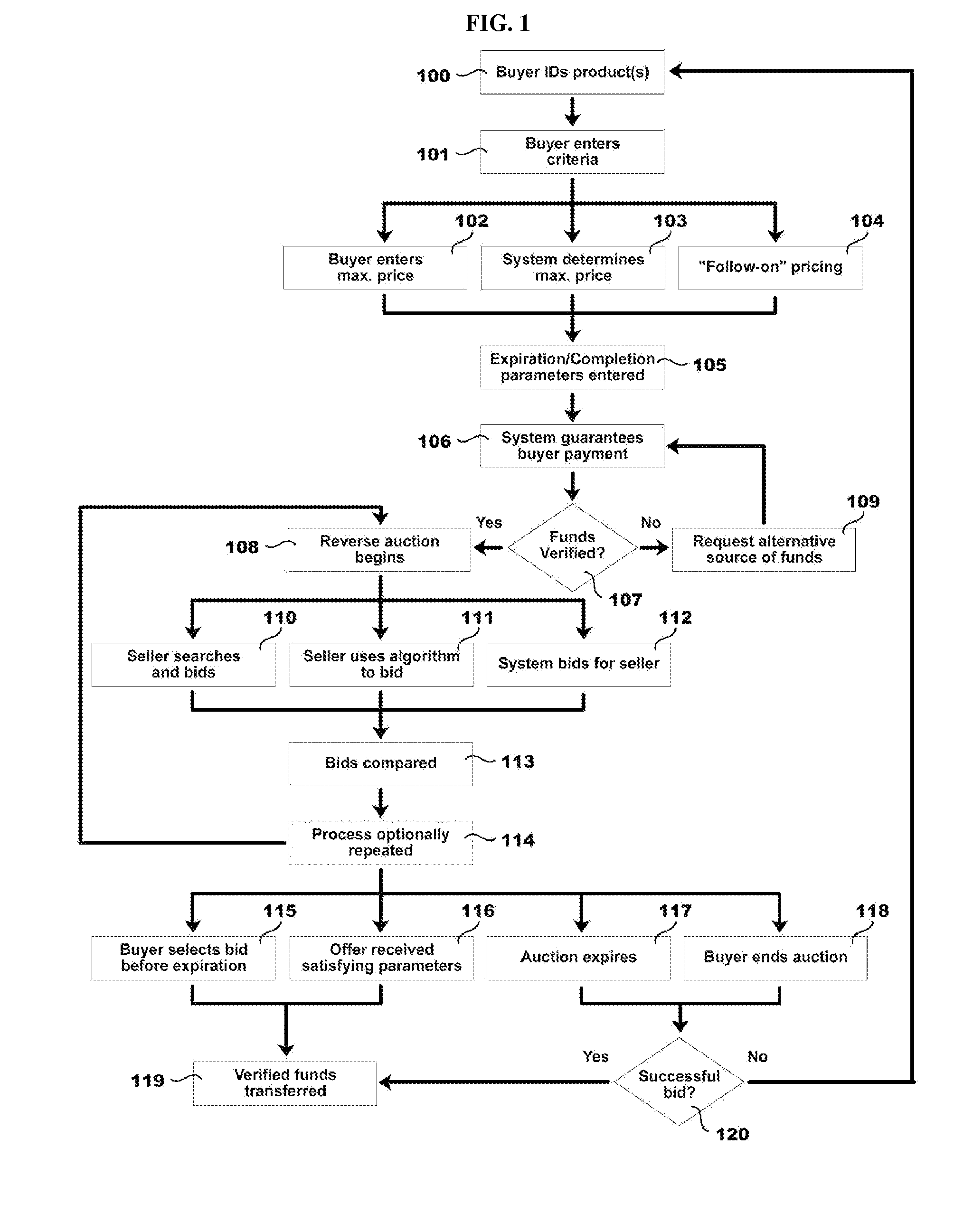Reverse auction system with guaranteed funds and dynamic sale allocation
a reverse auction and guaranteed funds technology, applied in the field of reverse auction systems with guaranteed funds and dynamic sale allocation, can solve the problems of time-consuming negotiating with individual buyers, seller's inability to know whether the consumer is telling the truth, and difficulty in gauging the seriousness of buyers, etc., to achieve transparency and trust.
- Summary
- Abstract
- Description
- Claims
- Application Information
AI Technical Summary
Benefits of technology
Problems solved by technology
Method used
Image
Examples
example 1
Offer and / or Bid Pricing Guidance
[0584]In this non-limiting example, a buyer intends to purchase a television with a MSRP of $1,000 and a smartphone with a MSRP of $600 using the platforms, systems, media, and methods described herein.
[0585]Using a graphical interface provided by the platforms, systems, media, and methods described herein, the buyer initiates a 7 day reverse auction to purchase the television and the smartphone for a total price of no more than $1400 (i.e. a reserve price of $1400). Also, using a graphical interface provided by the platforms, systems, media, and methods described herein, the buyer inputs their credit card number in order to verify at least $1400 is available to purchase the television and the smartphone. The platforms, systems, media, and methods described herein place a hold for $1400 on the buyer's credit card.
[0586]The platforms, systems, media, and methods described herein send a notification (i.e. an email, phone call, and / or a text message) to...
example 2
Offer and / or Bid Pricing Guidance
[0588]In this non-limiting example, a buyer intends to purchase a television with a MSRP of $1,000 using the platforms, systems, media, and methods described herein. The platforms, systems, media, and methods described herein are configured to provide guidance for the buyer of the television. In this example, the guidance indicates that the average profit margin for the market sector that sells televisions is 8%. Further, based on historical data collected by the platforms, systems, media, and methods described herein, the guidance indicates 97% of sales occur with a winning selling bid between $980 and $999, 54% of sales occur with a winning selling bid between $960 and $979, 19% of sales occur with a winning selling bid between $940 and $959, 8% of sales occur with a winning selling bid between $920 and $939, 3% of sales occur with a winning selling bid between $900 and $919, and 0% of sales occur with a price below $900. This information is presen...
example 3
Limited Time Bidding
[0590]In this non-limiting example, a buyer intends to purchase a television using the platforms, systems, media, and methods described herein. The buyer initiates a 10 day reverse auction to purchase the television for an offer price of $900. The buyer specifies the make and model of the television. After initiating the reverse auction, a plurality of sellers submit bids, some of which are below the buyer's offer price. Further, a first seller submits a bid of $890 and submits a limited time bid of $850 if the buyer chooses them within the next 60 minutes. The limited time bid convinces the buyer to accept the bid within the next 60 minutes and end the auction before the end of the 10 day time period.
[0591]In another embodiment of this non-limiting example, a buyer intends to purchase a television using the platforms, systems, media, and methods described herein. The buyer initiates a 10 day reverse auction to purchase the television for an offer price of $900. ...
PUM
 Login to View More
Login to View More Abstract
Description
Claims
Application Information
 Login to View More
Login to View More - R&D
- Intellectual Property
- Life Sciences
- Materials
- Tech Scout
- Unparalleled Data Quality
- Higher Quality Content
- 60% Fewer Hallucinations
Browse by: Latest US Patents, China's latest patents, Technical Efficacy Thesaurus, Application Domain, Technology Topic, Popular Technical Reports.
© 2025 PatSnap. All rights reserved.Legal|Privacy policy|Modern Slavery Act Transparency Statement|Sitemap|About US| Contact US: help@patsnap.com



